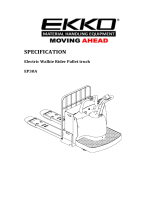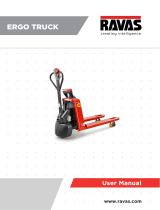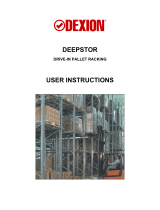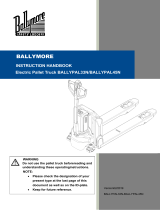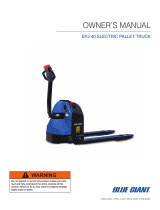11.14 EN
6
E Operation ................................................................................ 41
1 Safety Regulations for the Operation of the Forklift Truck....................... 41
2 Displays and Controls.............................................................................. 43
2.1 Operator platform position in drive direction............................................ 43
2.2 Second control station (o) in load direction ............................................ 45
2.3 Auxiliary lift controls................................................................................. 47
2.4 Pedestrian EKS 110 with gates ............................................................... 48
2.5 Deadman button and gate ....................................................................... 49
2.6 Displays ................................................................................................... 50
3 Starting up the truck ................................................................................ 52
3.1 Checks and operations to be performed before starting daily operation . 52
3.2 Setting up the operator position............................................................... 53
4 Industrial Truck Operation ....................................................................... 54
4.1 Safety regulations for truck operation...................................................... 54
4.2 Preparing the truck for operation ............................................................. 56
4.3 Parking the truck securely ....................................................................... 57
4.4 Emergency Disconnect............................................................................ 57
4.5 Deadman button ...................................................................................... 58
4.6 Travel....................................................................................................... 59
4.7 Steering ................................................................................................... 60
4.8 Brakes ..................................................................................................... 60
4.9 Travelling in pedestrian touch mode (o) ................................................. 62
4.10 Operator platform lifting and lowering...................................................... 64
4.11 Auxiliary Lift – raising and lowering ......................................................... 66
4.12 Lifting and lowering in pedestrian touch mode ........................................ 68
4.13 Lifting and lowering the operator platform with lift cutout (o).................. 72
4.14 Lifting, transporting and depositing loads ................................................ 74
4.15 Adjusting the forks ................................................................................... 75
4.16 Walk-on load section with pallet guard (o) ............................................. 76
4.17 Negotiating narrow aisles ........................................................................ 78
4.18 Trucks with rail guidance and aisle recognition (o) ................................ 80
4.19 Emergency lowering ................................................................................ 83
5 CanCode keypad..................................................................................... 85
5.1 Keypad .................................................................................................... 85
5.2 Parameters .............................................................................................. 86
5.3 Parameter Settings.................................................................................. 86
6 Troubleshooting....................................................................................... 90
6.1 Truck does not start................................................................................. 90
F Industrial Truck Maintenance .................................................. 93
1 Operational Safety and Environmental Protection................................... 93
2 Maintenance Safety Regulations............................................................. 93
3 Servicing and Inspection ......................................................................... 99
4 Maintenance checklist ............................................................................. 100
4.1 Operating company ................................................................................. 100
4.2 Customer Service .................................................................................... 102
5 Lubricants and Lubrication Schedule ...................................................... 107
5.1 Handling consumables safely.................................................................. 107
5.2 Lubrication Schedule ............................................................................... 109
11.14 EN
6
E Operation ................................................................................ 41
1 Safety Regulations for the Operation of the Forklift Truck....................... 41
2 Displays and Controls.............................................................................. 43
2.1 Operator platform position in drive direction............................................ 43
2.2 Second control station (o) in load direction ............................................ 45
2.3 Auxiliary lift controls................................................................................. 47
2.4 Pedestrian EKS 110 with gates ............................................................... 48
2.5 Deadman button and gate ....................................................................... 49
2.6 Displays ................................................................................................... 50
3 Starting up the truck ................................................................................ 52
3.1 Checks and operations to be performed before starting daily operation . 52
3.2 Setting up the operator position............................................................... 53
4 Industrial Truck Operation ....................................................................... 54
4.1 Safety regulations for truck operation...................................................... 54
4.2 Preparing the truck for operation ............................................................. 56
4.3 Parking the truck securely ....................................................................... 57
4.4 Emergency Disconnect............................................................................ 57
4.5 Deadman button ...................................................................................... 58
4.6 Travel....................................................................................................... 59
4.7 Steering ................................................................................................... 60
4.8 Brakes ..................................................................................................... 60
4.9 Travelling in pedestrian touch mode (o) ................................................. 62
4.10 Operator platform lifting and lowering...................................................... 64
4.11 Auxiliary Lift – raising and lowering ......................................................... 66
4.12 Lifting and lowering in pedestrian touch mode ........................................ 68
4.13 Lifting and lowering the operator platform with lift cutout (o).................. 72
4.14 Lifting, transporting and depositing loads ................................................ 74
4.15 Adjusting the forks ................................................................................... 75
4.16 Walk-on load section with pallet guard (o) ............................................. 76
4.17 Negotiating narrow aisles ........................................................................ 78
4.18 Trucks with rail guidance and aisle recognition (o) ................................ 80
4.19 Emergency lowering ................................................................................ 83
5 CanCode keypad..................................................................................... 85
5.1 Keypad .................................................................................................... 85
5.2 Parameters .............................................................................................. 86
5.3 Parameter Settings.................................................................................. 86
6 Troubleshooting....................................................................................... 90
6.1 Truck does not start................................................................................. 90
F Industrial Truck Maintenance .................................................. 93
1 Operational Safety and Environmental Protection................................... 93
2 Maintenance Safety Regulations............................................................. 93
3 Servicing and Inspection ......................................................................... 99
4 Maintenance checklist ............................................................................. 100
4.1 Operating company ................................................................................. 100
4.2 Customer Service .................................................................................... 102
5 Lubricants and Lubrication Schedule ...................................................... 107
5.1 Handling consumables safely.................................................................. 107
5.2 Lubrication Schedule ............................................................................... 109




















